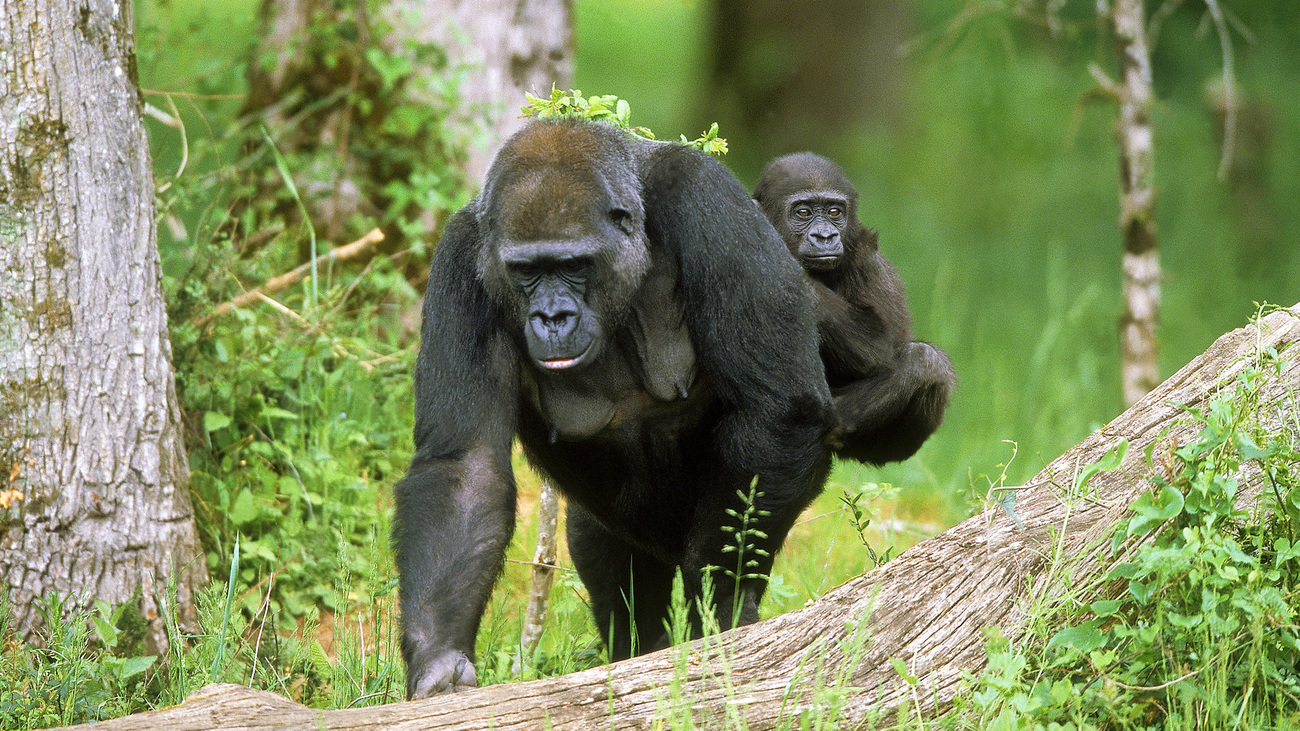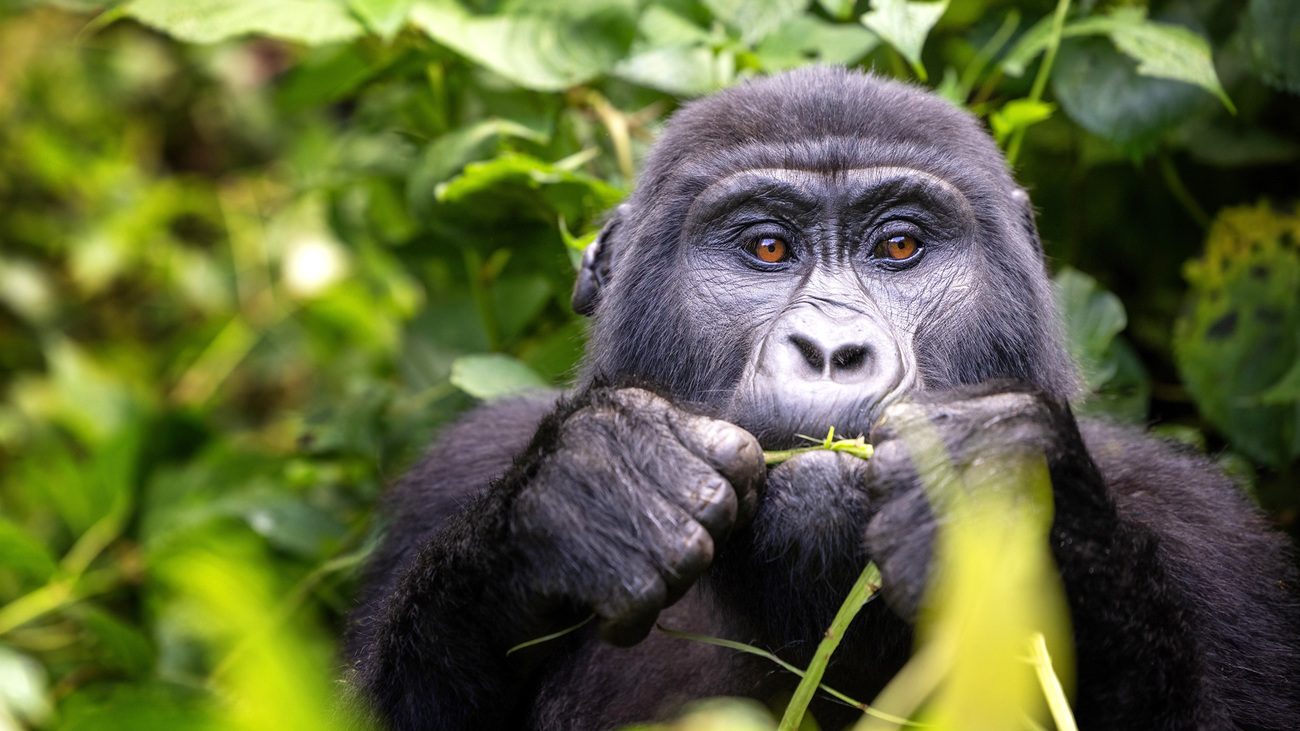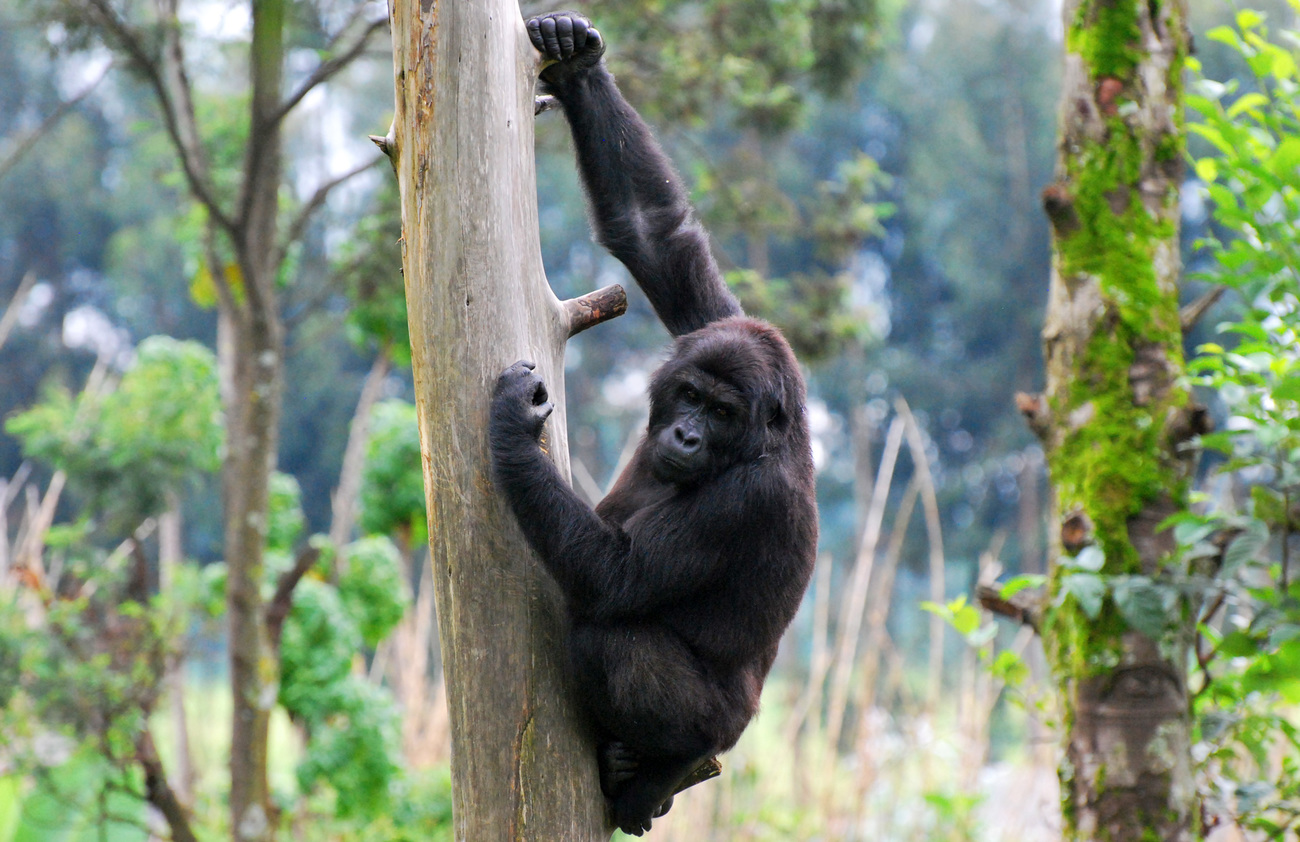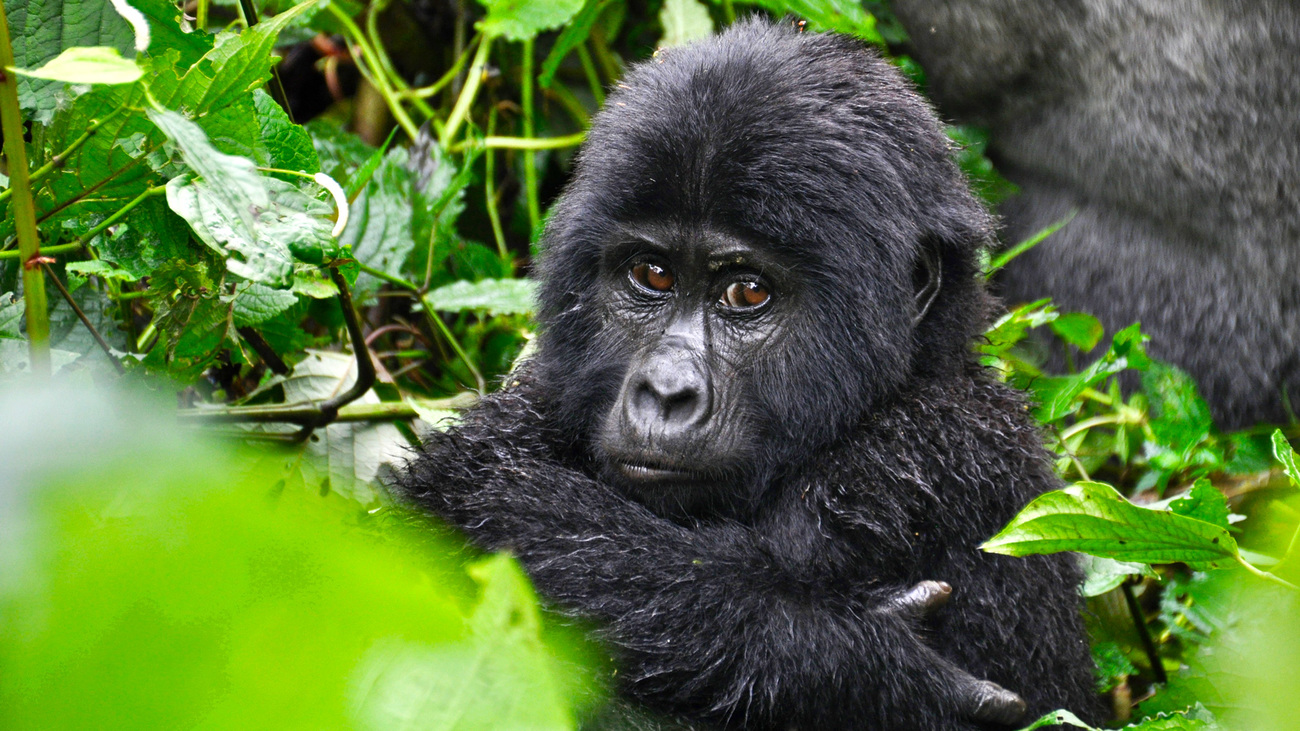Eastern gorillas
What is an eastern gorilla?
Eastern gorillas are a critically endangered great ape species found in the heart of Africa’s forests. Eastern gorillas can be divided into two subspecies—the eastern lowland gorilla (Gorilla beringei graueri) and the mountain gorilla (Gorilla beringei beringei). The eastern lowland gorilla is also called Grauer’s gorilla, especially among scientists.
Eastern lowland gorillas, or Grauer’s gorillas, are only found in the main tropical rainforest of the Democratic Republic of Congo. Here, they’re found in Kahuzi-Biega and Maiko National Parks, though much of their range encompasses unprotected forest areas.
As their name would suggest, mountain gorillas live in the mountains. The mountain gorilla subspecies is restricted to two separate areas of Afromontane forest—the Bwindi Impenetrable National Park in southwestern Uganda and Virunga Massif, a volcanic mountain range spanning the Democratic Republic of Congo, Rwanda, and Uganda.
Gorillas are one of humans’ closest genetic relatives, descending from a common ancestor 10 million years ago. Analysis of the gorilla genome found that gorillas share more than 96% of their genes with humans. Gorillas bear some physical and behavioral resemblance to humans. They have been observed to display various emotions, from laughing and playing to crying and grieving.
Eastern gorillas are particularly social creatures, living in groups known as troops or bands. These groups are usually led by a dominant alpha male called a silverback gorilla. Troop sizes can range from a few individuals to 30 eastern gorillas. The troops comprise the lead silverback, female gorillas, their offspring, and some younger, subordinate males. Eastern gorillas form strong social and familial bonds within their troops through grooming, play, and communication via complex vocalizations and body language.
Gorillas don’t have a fixed breeding season. Females give birth to a single offspring once every four years, after a gestation period of approximately eight and a half months. On rare occasions, they may give birth to twins. Newborn gorillas weigh only around two kilograms (4.4 pounds). Baby gorillas are vulnerable and carried around in their mother’s arms during their first three months. Young gorillas are similar to human children and exhibit playful behavior, like chasing one another and swinging from trees.
At age 10, female gorillas reach sexual maturity. Once they’ve reached this milestone, they will either move into another troop or find a lone silverback. While males do reach sexual maturity slightly earlier at age 9, they usually won’t reproduce until they reach 12 or 15 years old. They will go on to leave their group and seek out females to form their own troops. This can sometimes result in aggression—young males will attempt to remove females from their existing troops—and the death of infants. Some males will stay in their original family troops and take on the role of the silverback upon the death or incapacity of the father. Wild gorillas can live up to 35 years old. In captivity, some gorillas can live past 40 years old.
Both the eastern lowland gorilla and the mountain gorilla have robust, muscular bodies, with strong chests and protruding abdomens. Their black skin is covered in coarse, dark fur that helps protect them from the elements of their forest habitats. This fur covers everything except for their faces, hands, and feet, plus the chests of older males.
Mountain gorillas tend to have longer hair than Grauer’s gorillas, which helps them in colder, harsher mountain climates. Eastern gorillas are usually larger than other gorilla species, though they have slightly shorter arms. Generally, a gorilla’s arms are 15 to 20% longer than their legs. Adult male eastern gorillas are larger than adult females, weighing between 135 and 220 kilograms (300-485 pounds). Females are about half that weight at 70 to 90 kilograms (154-198 pounds). Males typically grow to 1.7 meters (5.5 feet) tall, while females are slightly shorter at 1.5 meters (4.9 feet).
Gorillas walk around on all fours in a knuckle-walking movement, using their hands’ knuckles to support their weight. Every now and then, gorillas will stand upright, though it’s usually in a display of dominance. While females and children have been observed to climb trees, the sheer weight of males means that they cannot climb as easily.
Eastern gorillas are usually gentle, non-aggressive animals. They are primarily herbivores with a diet of herbs, leaves, bark, vines, bamboo and fruit. Sometimes, they’ll also eat insects. Both subspecies spend much of their day foraging for food in dense tangles of forest growth.
Grauer’s gorillas and mountain gorillas are both important contributors to their forest ecosystems. Their feeding habits help disperse seeds, contributing to the biodiversity of their forest habitats. Gorillas also prune plants, which helps encourage plant growth. It also opens up spaces within the forest, allowing sunlight to nourish the rest of the plants. Maintaining the health of this ecosystem is crucial to maintaining the overall health of our planet, as forests serve as carbon sinks, absorbing and storing vast amounts of carbon dioxide.
What is an eastern gorilla’s scientific name?
The scientific name for an eastern gorilla is Gorilla beringei. This species comprises two subspecies—the eastern lowland gorilla, scientifically known as Gorilla beringei graueri, and the Mountain gorilla, scientifically known as Gorilla beringei beringei.
The eastern lowland gorilla is also called Grauer’s gorilla, named after Rudolf Grauer, the Austrian zoologist and explorer who first observed them as a separate subspecies.
Are eastern gorillas endangered?
The IUCN Red List classifies eastern gorillas as critically endangered, with 2,600 mature individuals left in the wild.
The mountain gorilla, a subspecies of eastern gorillas, is endangered, with a population of 600.
The eastern lowland gorilla—another subspecies—is critically endangered and has a decreasing population. While the exact number of individuals is unknown, in 2015, roughly 3,800 individuals remained. From 2015 to 1994, they experienced a population decrease of at least 77%.
Where do eastern gorillas live?
Eastern gorillas are found in East and Central Africa.
Mountain gorillas inhabit Virunga Massif, a chain of volcanic mountains that spans Rwanda, Uganda, and the Democratic Republic of Congo. Here, they’re found at an altitude of 1.85 kilometers (1.1 miles) or higher. They are also found at an altitude of 1.4 kilometers (0.86 miles) or above in the Bwindi Impenetrable Forest in Uganda.
Grauer’s gorillas (also called eastern lowland gorillas) live in the lowland tropical forests of eastern Democratic Republic of Congo. These forests are part of the Congo Basin, one of the world’s most significant tropical rainforest regions.
Threats
Eastern gorillas are a critically endangered species that face several threats to their survival, including poaching, habitat loss, civil unrest, disease, and climate change.

Poaching
Hunting or poaching any member of the great apes family is illegal under the Convention on International Trade in Endangered Species of Wild Fauna and Flora (CITES). Yet, it persists as a significant threat to eastern gorillas, particularly Grauer’s gorillas (eastern lowland gorillas). They’re mainly hunted for bushmeat, an activity driven by several factors, like the demands of a growing population and a lack of affordable protein in rural areas.
Habitat loss
In the Democratic Republic of Congo, agricultural activities encroach on gorilla habitats. While there currently aren’t any ongoing commercial logging operations, the area is tapped for resources, which strains the ecosystem. Illegal mining has particularly affected Kahuzi-Biega National Park, where Grauer’s gorillas live.
Civil unrest
Refugees, displaced communities, and armed groups have settled in forests in the Democratic Republic of the Congo, carrying out uncontrolled habitat conversion for human activities like agriculture, timber extraction, and mining. As part of the ongoing political unrest, there has been a significant increase in the illegal circulation of weapons, which has led to an increase in the hunting and commercial trade of bushmeat.
Disease
Eastern gorillas are susceptible to some human diseases because they are genetically similar to humans. Though tourism is a critical part of the strategy for conserving eastern gorilla populations, it also increases the risk of transmitting these diseases, including respiratory viruses, the human herpes simplex virus, and scabies.
Climate change
Climate change can impact the habitats of eastern gorillas, causing them to migrate to higher altitudes. Higher temperatures and changing rainfall patterns due to climate change can also change the availability of their food source and the quality of their habitats.
FAQs
How many mountain gorillas are left?
There are around 600 mature individual mountain gorillas left.
Why are mountain gorillas endangered?
Mountain gorillas are endangered due to a series of threats. Despite being illegal, hunting remains one of the biggest threats to the species, along with the loss of habitat due to human encroachment, civil unrest, disease, and climate change.

What do mountain gorillas eat?
Mountain gorillas are primarily herbivores, and their diets consist of the leaves, shoots, and stems of plants, including wild celery and bamboo. They also occasionally consume insects.
How many eastern lowland gorillas are left?
The exact number of eastern lowland gorillas, or Grauer’s gorillas, is unknown. In 2015, it was estimated that there were around 3,800 left, distributed across 11 sites. However, since 2015, their numbers have declined.
How big is the eastern lowland gorilla?
Male eastern lowland gorillas weigh 135 to 220 kilograms (300 to 485 pounds), about twice as much as females at 70 to 90 kilograms (154 to 198 pounds). They can reach 1.7 meters (5.5 feet) in height, while females reach 1.5 meters (4.9 feet).

Are eastern gorillas bigger than western gorillas?
Eastern gorillas tend to be bigger than western gorillas. The eastern lowland gorilla is the largest of all four gorilla subspecies, while the western lowland gorilla is the smallest.
Why is the eastern lowland gorilla endangered?
The eastern lowland gorilla, also known as Grauer’s gorilla, is endangered due to a combination of threats to the species’ survival. Despite legal protections, one of the most pressing threats is poaching for bushmeat. Habitat loss also puts their population at risk, especially from land conversion for human activity, including agriculture and mining.
Civil unrest has also contributed to the decreasing population of eastern lowland gorillas, resulting in uncontrolled habitat conversion from displaced communities. Additionally, national parks, designated to protect these gorillas, have fallen victim to human occupation, resulting in increased hunting and the illegal trade of bushmeat due to the proliferation of weapons.
Sharing a significant portion of their DNA with humans, eastern lowland gorillas are susceptible to various human diseases. Though the funding it provides is essential for conserving gorilla populations, tourism inadvertently introduces the risk of disease transmission.
Climate change also threatens eastern lowland gorillas’ survival. Shifts in temperature and rainfall patterns impact their habitats, altering the availability and quality of their food sources. This disruption forces gorillas to migrate to higher altitudes in search of suitable habitats, further stressing their already vulnerable populations.
Why do gorillas beat their chest?
Gorillas beat their chest to signal aggression and assert dominance. Beating their chests is a display of competitive ability. It can deter weaker gorillas from challenging dominant silverback gorillas and help prevent combat.
It’s a common myth that gorillas beat their chest with balled-up fists. In reality, they cup their hands to amplify the sound.

How can you help?
Poaching, habitat loss, human conflict, and disease are the biggest threats to eastern gorillas. As a critically endangered species, they need our help.
